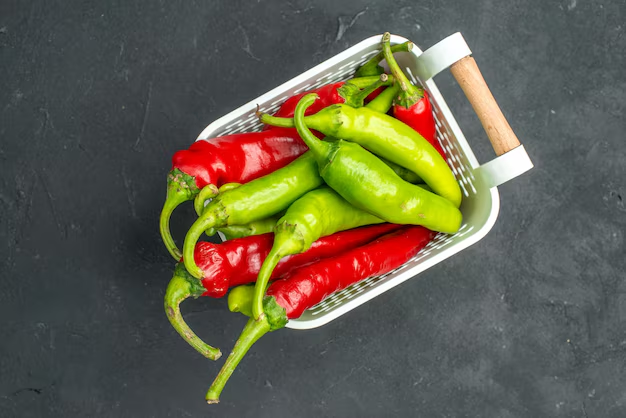What You Need to Know About Storing Red Peppers: How Long Do They Last in the Refrigerator?
Red peppers are vibrant, flavorful, and packed with nutrients, making them a staple in many households. But like all fresh produce, they come with a shelf life that requires some attention. Curious about how long you can store red peppers in your refrigerator and how to make them last longer? Let's peel back the layers and explore the ins and outs of storing these delightful veggies effectively.
Why Proper Storage Matters
Keeping red peppers fresh for as long as possible not only helps you cut down on food waste but also allows you to enjoy their peak flavors and nutritional benefits. Proper storage can make a significant difference, especially if you buy in bulk or don’t use peppers often.
Nutritional Highlights of Red Peppers
Before we dive into storage tips, it’s worth noting why red peppers deserve a special place in your diet. They are:
- Rich in Vitamin C: Red peppers are one of the highest sources of vitamin C, which is essential for a healthy immune system.
- Packed with Antioxidants: They contain antioxidants, such as beta carotene, which promote skin health and reduce the risk of chronic diseases.
- Low in Calories: With their low-calorie content, they make for a healthy snack or addition to meals without tipping the calorie scales.
Having understood their nutritional value, let's turn our attention to the essential question: how long do they last in the refrigerator?
Understanding the Shelf Life of Red Peppers
Freshness Timeline
Under ideal conditions, fresh red peppers can last in the refrigerator for about 1 to 2 weeks. The key to achieving this time frame is proper storage.
- Whole Peppers: These tend to last longer than those that have been cut. Once sliced, their shelf life decreases due to exposure to air and moisture.
- Cut Peppers: Sliced or chopped peppers usually last around 3 to 5 days when stored properly.
Factors Affecting Shelf Life
Several factors impact how long red peppers stay fresh:
- Temperature: Cooler temperatures slow down the ripening process, extending their freshness.
- Humidity: A damp environment can lead to mold and spoilage.
- Packaging: Proper packaging can help protect them from moisture and air, which can cause wilting and spoilage.
Best Practices for Storing Red Peppers
Whole Peppers
To maximize the freshness of whole red peppers, store them in your refrigerator's crisper drawer. This area maintains the ideal humidity level, helping to keep your peppers crisp and fresh.
- Tip: Place whole peppers in a paper bag or simply leave them out in the crisper. Plastic bags can trap moisture and cause them to spoil faster.
Cut Peppers
Once you've sliced your peppers, it’s crucial to store them properly to retain their freshness.
- Use Airtight Containers: Store cut peppers in an airtight container. You can also wrap them in paper towels to absorb excess moisture before sealing them in the container.
- Refrigerator Placement: Keep the container in the main body of the fridge rather than the door to avoid temperature fluctuations.
Signs of Spoilage to Watch For
Recognizing when your peppers have gone bad is as important as storing them correctly. Here's what to look out for:
- Wrinkled Skin: Slight wrinkling is a sign of dehydration but doesn't mean they're completely inedible. However, significant wrinkling often signals spoilage.
- Soft Spots and Discoloration: These are red flags. Soft, mushy spots and dark patches are strong indicators that the pepper has begun to spoil.
- Off Smell: A sour or off-putting smell is a definite sign that the pepper is no longer good to eat.
Related Subtopics: Extending the Life of Red Peppers
Beyond refrigeration, there are several methods to extend the shelf life of red peppers:
Freezing Red Peppers
Freezing is an excellent option if you have surplus peppers and want to avoid waste. Here's how you can freeze them:
- Wash and Dry: Thoroughly wash and dry the peppers to remove any contaminants.
- Cut and Prep: Remove the seeds and slice them into your preferred shapes.
- Blanching (Optional): Blanching them for a couple of minutes can help preserve their color and texture.
- Freeze: Place the peppers in a single layer on a baking sheet to freeze initially. Once frozen, transfer them to a freezer-safe bag or container.
Pickling Red Peppers
Pickling is another way to preserve peppers and add some zing to your meals. With a vinegar-based brine, you can easily extend their shelf life while creating a tasty condiment.
Drying Red Peppers
Dehydrating red peppers is a fantastic way to store them long term. You can use a food dehydrator or your oven set to a low temperature, resulting in flavorful, dried peppers perfect for soups and stews.
Quick Tips Summary
To ensure your red peppers stay fresh and vibrant, keep these quick tips in mind:
- 🧊 Store whole peppers in the crisper drawer for optimal humidity levels.
- 🥪 Use airtight containers for sliced peppers to minimize exposure to air.
- 🧼 Watch for signs of spoilage like soft spots and off smells.
- ❄️ Consider freezing surplus peppers to extend their usable life.
- 🥒 Explore pickling or drying as alternative preservation methods.
Conclusion: Embrace the Freshness
Keeping your red peppers fresh doesn't have to be a hassle if you follow the tips outlined above. Whether you’re a cooking enthusiast or someone who loves adding a pop of color and flavor to your dishes, understanding how to properly store and monitor the freshness of red peppers is invaluable. By thoughtfully storing and possibly freezing or preserving them, you not only save money and reduce waste but also ensure that you have access to these nutritional powerhouses whenever you need them. So, ensure your peppers are correctly stored and enjoy their crispness in all your culinary creations!
